A tank hunter fielding the feared 88 mm
After the first encounters with tanks like the T-34 and the KV-1 in the summer of 1941, the OKH was well aware that it had to quickly devise a response, in order to have the necessary firepower when needed. The long-period development projects, like the Panther and Tiger, were already on the agenda, but faster ways of fielding this kind of firepower were already available in the shape of self propelled guns, already tested and built since 1940.
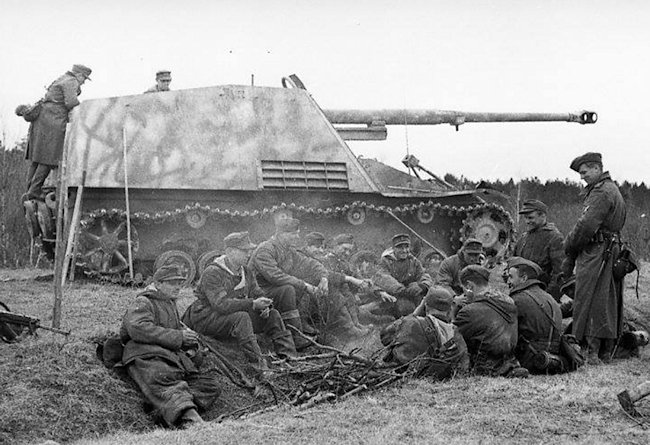
This photograph of a Nashorn 88mm self-propelled gun was taken in January 1944.
These were proven solutions, fast-built at low cost. Older tank hunters equipped with the Pak 40 75 mm (2.95 in) gun, like the Marder, were barely sufficient against the KV-1, so the adoption of the most efficient piece in the German ordnance came as a necessity. Following the specifications of 1942, a tank hunter was planned to carry the ubiquitous 88 mm (3.46 in) gun. It was to be built by Alkett (Altmärkische Kettenwerke GmbH) in Berlin.
Design
Alkett choose the Geschützwagen III/IV chassis to mount the heavy 8,8 cm Panzerabwehrkanone 43/1 L/71 (Pak 43/1), a lightweight version of the standard German AA gun, also mounted on the Tiger II tank.
The chassis was based on the Panzer IV, with the same suspension configuration with four bogies, each with two pairs of rubberized roadwheels, idlers at the rear and drive sprockets at the front, but lengthened and strengthened.
The hull armor was 30 mm (1.18 in) at the front, 20 mm (0.79 in) on the sides and 15 mm (0.59 in) for the rear plate. The engine was a Maybach HL 120 TRM Ausf.A V12 producing 300 hp@3000 rpm, with 11,867 L of displacement.
It was coupled with a ZF (Zahnradfabrik Friedrichshafen AG) SSG 77 Aphon transmission of the synchromesh manual type, with 6/1 gears. The driver had a Daimler-Benz/Wilson clutch/brake with a Fichtel & Sachs La 120 HDA dry clutch, triple disc.
The gun and its bearings were placed at the rear of the chassis, surrounded by an open-topped superstructure, which had a 15 mm (0.59 in) front and 10 mm (0.39 in) sides to protect the crew (only against shrapnel and small arms fire).
There was a 15 mm thick (0.59 in) gun shield inside the casemate, acting like an internal mantlet and allowing some traverse, 15° to either side and between -5° in depression and +15° in elevation. To balance the weight, the engine was shifted from its rear position to the center.
The gun was semiautomatic, with an horizontal sliding block, manual traverse and elevation. The casemate and hull could carry from 24 to 40 rounds, crammed into any space available, of the Pzgr.39 (Armor Piercing Composite Ballistic Cap) tungsten-core type, which could penetrate 132 mm (5.2 in) at 2000 m.
There was no secondary armament except one 7.92 mm (0.31 in) MG 34 or MG 42 machine-gun carried inside the vehicle, with 600 rounds in store. The gun was aimed by a gunner’s sight with a 5x magnification, 8° field of view, and had an indirect fire sight Aushilfsrichtmittel 38 with a 3x magnification, 10° field of view. There was also a FuG Spr.f radio.
Production & variants
The model, called “Hornisse” (Hornet) initially, was presented to Hitler in October 1942, approved, and production began in January 1943 as the 8,8 cm Pak 43 (L/71) auf Fahrgestell Panzerkampfwagen III/IV (Sf) or 8,8cm Pak 43 (L/71) auf Geschützwagen III/IV (Sd.Kfz.164).
In May 1943, a new model was introduced, featuring a new driver’s front armor plate, 15 mm (0.59 in) uniform gun shield and some other minor differences.
This new version represented the bulk of Alkett’s production until early 1944, when it was slowed but not stopped. Some models received the wider “Ostketten” tracks, adapted to the Russian winter and autumn, making the overall width rise to 3.17 m (10ft4), instead of 2.95 m (9ft8).
Hitler renamed it “Nashorn” (Rhinoceros) in 1944, and this name stuck to the series ever since. Some authors, however, make the distinction between the early and late series using the two names. By 1944, new tank hunters, with a lower silhouette and much better protection, like the Jagdpanther, were favored by the OKH.
The bulk of the 494 vehicles produced were delivered in 1943 (345), however the remainder were delivered discontinuously, 133 from February to November 1944, and only 16 from January to March 1945.
The Sd.Kfz.164 Nashorn in action
When entering service, the Hornisse was issued to six of the newly-formed heavy antitank battalions, the schwere Panzerjäger Abteilungen 560, 655, 525, 93, 519 and 88, each with 45 vehicles. The main gun was derived from the regular 88 mm (3.46 in) Pak 43, one of the most effective anti-tank guns of the war, and later used, with few modifications, on the Ferdinand/Elefant, Tiger II and Jagdpanther.
In addition, the Panzergranate 40/43 tungsten carbide–cored round could defeat 190 mm (7.48 in) of RHA at a 30° angle at 1,000 m. This allowed the Hornisse to engage enemy units while staying out of range themselves. So there was no need for armor protection. It was reported several times that T-34s were destroyed at distances of around 4000 meters, in almost direct fire. Usually, the prey were the “hard-skinned” KV, IS-2, SU-152, ISU-122 and ISU-152.
This made the Nashorn the first of the German alpha predator bred for the Eastern Front. The Sd.Kfz.164 was first blooded at the Battle of Kursk, and performed quite well, engaging heavies like the KV-1. Its long-range ability was found particularly adapted to the open and flat landscapes of Russia. Added to this, the open fighting compartment gave excellent peripheral vision compared to an enclosed turret.
After Kursk, three of these Abteilungen, the 560 sPzJagAbt, 655th sPzJagAbt and 525 sPzJagAbt, were sent to Italy. They again proved to be successful tank destroyers. Six more schwere Panzerjager Abteilungens (560, 655, 525, 93, 519 and 88), each equipped counting 30 Nashorns, saw service on the Eastern Front, Normandy and Italy. Each Abteilung was composed of a command company and 2-3 companies (14-17 tank hunters each) with 4 platoons each.
There was a Nashorn ace, platoon commander of 1st company, sPzJagAbt 519, Junior Lieutenant “Tiger of Vitebsk” Albert Ernst. On December, 23, 1943, he destroyed 14 Soviet tanks in a single day with 21 rounds near Vitebsk. In December 1943, he destroyed 19 more enemy tanks and was awarded the Knight’s Cross.
Lieutenant Beckmann from sPzJagAbt 88, destroyed a Soviet IS-2 at the amazing distance of 4600 meters near Marzdorf in March 1945. A Nashorn from the 2nd Company, Abteilung 93 destroyed the only M26 Pershing in Europe, at 250 meters, with the first shot, in Niehl, north of Cologne, March 6, 1945.
Links and resources about the Sd.Kfz.164 Nashorn
The Nashorn on Wikipedia
Tank-Hunter.com
The Nashorn on Achtung Panzer
Czechoslovakian Army records
Gallery
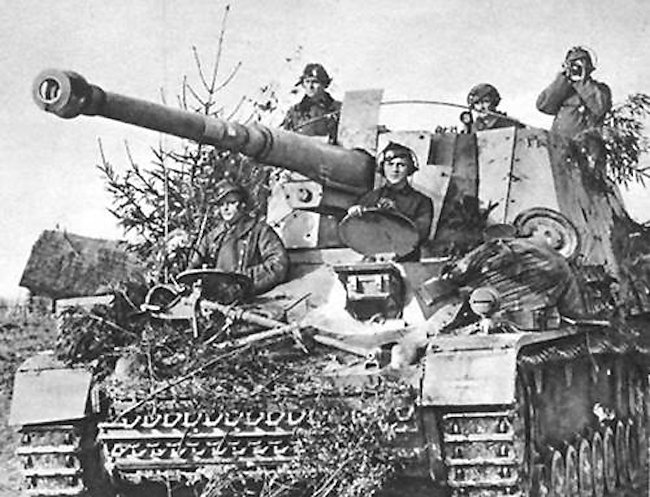
The German Nashorn self propelled 88mm gun had a five man crew
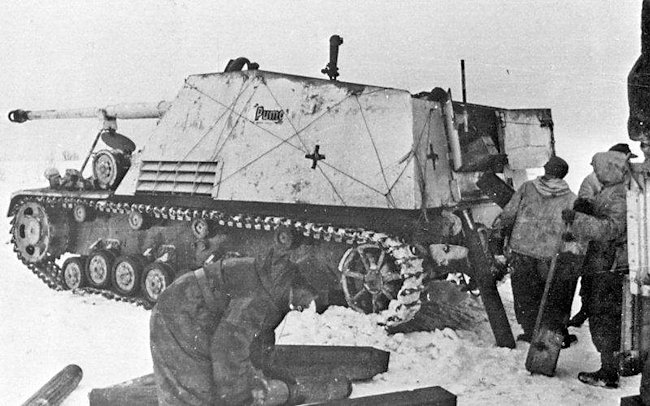
Nashorn 88mm self-propelled gun in winter whitewash livery on the Eastern Front. The crew are loading ammunition.
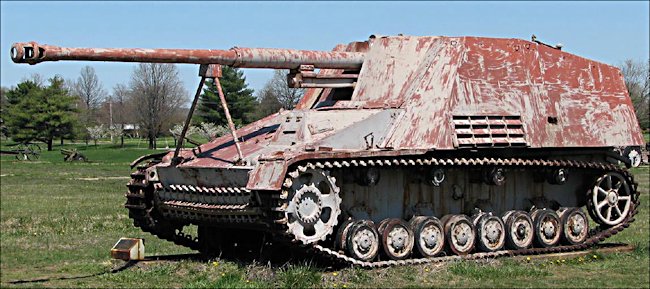
German Nashorn self propelled gun was used as a tank destroyer. It can be found at the U.S. Army Center for Military History Storage Facility, Anniston, AL, USA
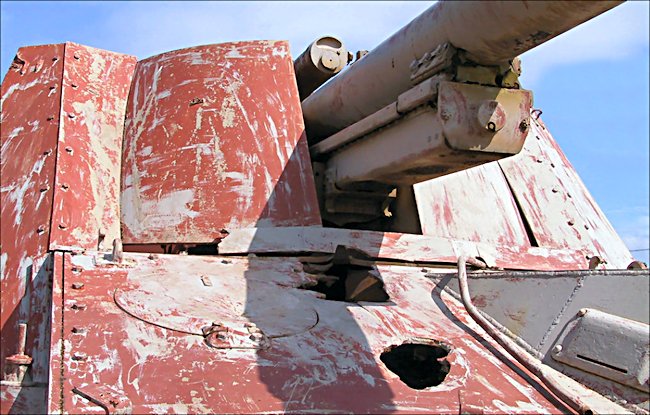
The 88mm tank killing gun was mounted on the specially designed Geschützwagen III/IV tank chassis
Sd.Kfz.164 Nashorn specifications |
|
| Dimensions (L-W-H) | 8.44m (7.26m without gun) x 2.95m x 2.65m 27’8″ (23’10” without gun) x 9’8″ x 8’8″ ft.inch |
| Total weight, battle ready | 24 tons (52,910 lbs) |
| Armament | 88 mm (3.46 in) L/60 Pak 43/1 |
| Armor | Hull 20-30 mm (0.78-1.18 in) Sides 10-15 mm (0.39 – 0.59 in) |
| Crew | 4/5 (driver, commander, gunner, loader) |
| Propulsion | Maybach 11.9 liter V-12 gasoline 300 PS (296 hp, 221 kW), 12 hp/t |
| Speed | 42 km/h (26 mph) |
| Suspension | Leaf spring |
| Range and consumption | 235 km (146 mi), 470 l/100 km |
| Total production | 394 |
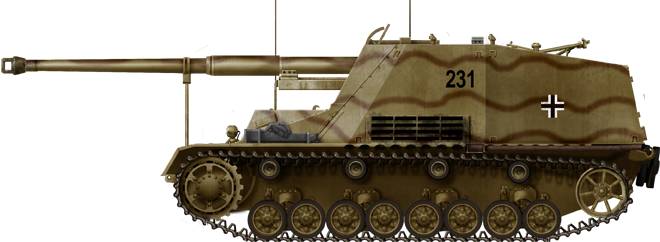
Sd.Kfz.164 Hornisse of the 2nd Schwere Panzerjäger Abteilungen 560, Kursk, summer 1943.
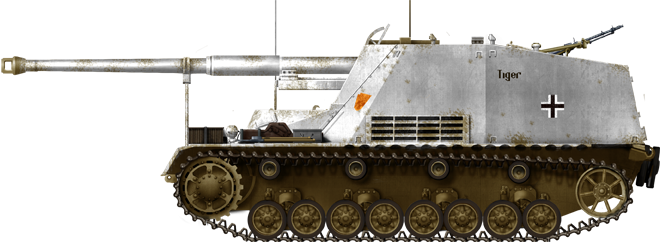
Hornisse of the schwere Panzerjäger Abteilungen 519, Group center, Vitebsk area, Russia, winter 1943-44.
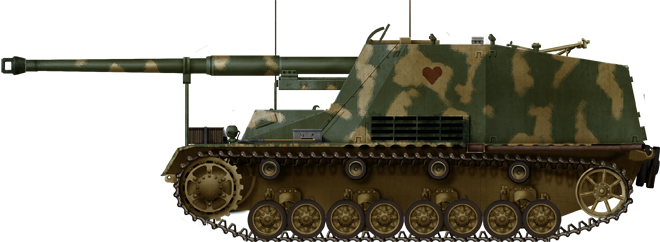
Nashorn of the schwere Panzerjäger Abteilungen 88, Russia.
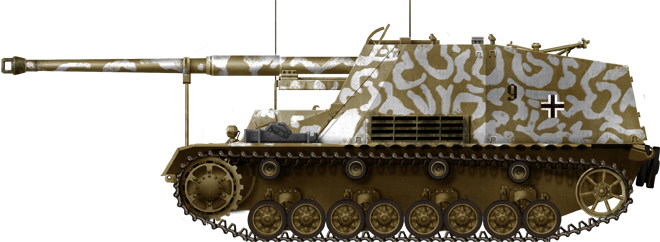
Another Nashorn of the schwere Panzerjäger Abteilungen 88, Russia, 1944.
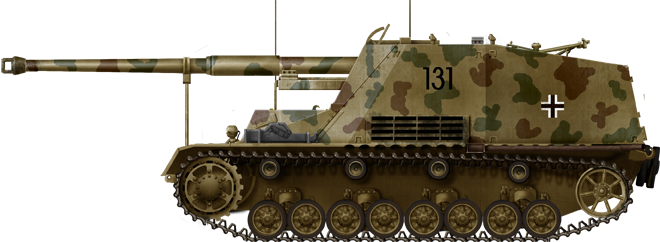
Sd.Kfz.164 Nashorn of the schwere Panzerjäger Abteilungen 525 in Italy, summer 1944.
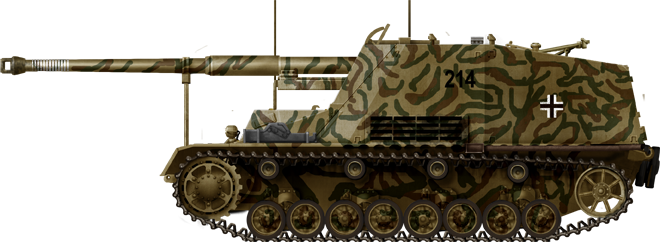
Sd.Kfz.164 Nashorn in Italy, schwere Panzerjäger Abteilungen 164.

WW2 Tanks




























WW2 tanks posters

All Tiger tanks liveries.

Panther liveries and variants

WW2 Armour - All tanks











Tanks aces and single tanks series

Find more there

Museums, Movies, Books & Games
The Tanks and Armor in pop culture
Tanks and armored vehicles in general are only really grasped when seen first person: The mass, the scale, it's all there. Explore also the way tanks were covered in the movie industry, in books and in video games.Movies:
Best tanks movie on warhistoryonline.com
On imdb.com
On bestsimilar.com/
miltours.com
liveabout.com/
watchmojo.com
Video Games:
pcgamesn.com
historyhit.com
levvvel.com
vg247.com/best-tank-games
mmobomb.com/
alienwarearena.com


